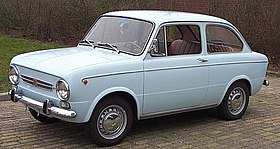Fiat 850
| Fiat 850 | |
|---|---|

1968 Fiat 850 Special
|
|
| Overview | |
| Manufacturer | Fiat |
| Production | 1964–1973 |
| Designer |
|
| Body and chassis | |
| Class | Supermini (B) |
| Body style | |
| Layout | Rear-engine, rear-wheel-drive |
| Related | SEAT 850 |
| Powertrain | |
| Engine |
|
| Transmission |
|
| Dimensions | |
| Wheelbase | 2,027 mm (79.8 in) |
| Length | 3,575 mm (140.7 in) (saloon) 3,735 mm (147.0 in) (Familiare) |
| Width | 1,425 mm (56.1 in) (saloon) 1,500 mm (59.1 in) (Familiare) |
| Height | 1,385 mm (54.5 in) (saloon) 1,655 mm (65.2 in) (Familiare) |
| Kerb weight | 670 kg (1,477 lb) (saloon) |
| Chronology | |
| Predecessor | Fiat 600 |
| Successor |
Fiat 127 Fiat 133 Fiat X1/9 (Spider) Fiat 900T (Familiare) |
The Fiat 850 (Tipo 100G) is a small rear-engine, rear-wheel-drive car manufactured and marketed by Italian car manufacturer Fiat from 1964 to 1973.
Its technical design was an evolution of the successful Fiat 600. The internal name for the Fiat 600 development project was "Project 100" and consequently, the internal Fiat codename for the 850 project was 100G (G was a follow on of model designations for the 600 which ran from A to F). The engine of the 850 was based on that of the Fiat 600, but had its capacity increased to 843 cc. The 850 came in two versions: "normale" (standard) with 34 hp (25 kW) and "super" with 37 hp (28 kW). The maximum speed was approximately 125 km/h (78 mph). While it was not a large step forward in technical development, it possessed a certain charm with its large rolling eyes and its short tail, in which the engine sat.
The 850 family included several body styles sharing core technical components:
At the time of their introduction into the United States the Sedan, Coupé, and Spider were marketed with a reduced capacity, high compression 817 cc (50 cu in) engine in order to beat US emissions regulations at the time which applied only to engines equal to or larger than 50 cubic inches. Compression was raised from 8.8:1 to 9.2:1, requiring premium octane fuel.
In order to separate the sportier variants Coupé and Spider from the basic version, apart from the increase of engine performance, the equipment was also extended and adapted to the higher expectations. Both received sport seats, a sport steering wheel and round speedometer; Spider even received a completely rearranged instrument panel. The front drum brakes were replaced with disc brakes, although drum brakes remained on the rear wheels.
In 1968, Fiat revised the successful Spider and Coupé again and gave them an even stronger engine with 903 cc and 52 hp (39 kW). They were called Sport Spider and Sport Coupé. The Sport Spider body stayed essentially the same, but with a restyled front. The headlamps were moved forward slightly and the glass covers were eliminated giving the car a "frog-eye" look, and the original flush front turn indicators were replaced with units hung below the bumper. Several limited special edition versions of the Spider were offered, including the Racer featuring a body-colored metal hard top and the Racer Berlinetta featuring a black vinyl hard top.
There was a minivan and transporter model as a successor of the world's first minivan, Fiat 600 Multipla, which was later renamed to 900T and likewise received the larger capacity of 903 cc.
...
Wikipedia
